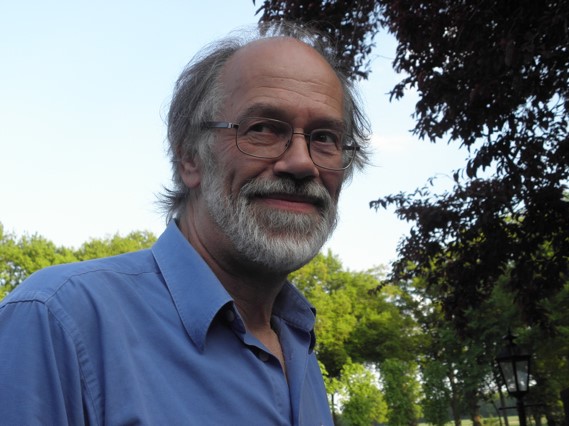 Ger de Bruyn (de Bruyn family photograph)
Ger de Bruyn (de Bruyn family photograph)
Ger de Bruyn
Contributed by Thijs van der Hulst
Antonius Gerardus (Ger) de Bruyn was born on 13 July 1948 and died 9 July 2017. He studied astronomy at the University of Leiden and received his doctorate in 1976 on a thesis entitled "Radio investigations of active spiral and Seyfert galaxies" under the supervision of Prof. Harry van der Laan. His thesis research was based on early radio continuum observations with the Westerbork Synthesis Radio Telescope, the premier instrument for Ger's research throughout his entire career until the inception of LOFAR in 2003/4. Before joining the scientific staff at ASTRON (the Netherlands Institute for Radio Astronomy) in 1978, he spent two years at the Carnegie Institute/Hale Observatory in Pasadena as a Carnegie Fellow, where he used the Hale Observatory facilities to obtain optical spectra of many active galaxies of the kind he studied for his thesis.
Back in the Netherlands, he devoted most of his attention to using the Westerbork Telescope at its limits to address a broad range of scientific questions. This was possible due to his excellent and ever-increasing understanding of synthesis imaging, including all the subtle effects of the earth's troposphere and ionosphere, the telescopes, the receivers, the backend and the correlator. Ger's drive to get the most out of the telescope made him famous amongst his peers, and for several decades Ger and his technical colleagues at ASTRON continually pushed the telescope to its limits by coupling forefront scientific research to creative and clever methods for processing the data. This led to the introduction of the so-called redundancy calibration, making use of the regular layout of the antennas of the Westerbork array. The redundancy calibration has made it possible to reach record dynamic-range radio images with this telescope.
Over the years the frequency coverage of the Westerbork telescope was expanded to both higher and lower frequencies, and Ger and his colleagues and students made enormous progress, especially at the lowest frequencies. An attempt to find signs of very distant neutral-hydrogen objects led to the discovery of very complex polarized emission from the galaxy. Follow-up research has shown that this complexity is pervasive in our Galaxy. To study these structures in detail, Ger and his colleagues and students introduced a new technique, rotation measure synthesis, which brings out these complex structures in all their detail and is a powerful tool for its interpretation.
In the late nineties the Westerbork array was used to image the radio emission of the entire northern sky at low frequency (327 MHz), and Ger played a pivotal role in the planning, calibration and analysis of this survey, the Westerbork Northern Sky Survey WENSS. The catalogues and images of this survey are a great asset for the general astronomical community and are widely used.
Some twenty years ago the idea was worked out that it should be possible to measure the extremely weak signal of neutral hydrogen in the early universe once it is heated by the first generation of stars. Ger was intimately involved in this effort. This turned out to be one of the prime motivations to build the Low Frequency Array LOFAR, designed by ASTRON engineers and realized about ten years ago. Ger, his colleagues and students prepared carefully to use LOFAR to detect the neutral-hydrogen signatures in the early universe. Efforts to detect these signatures are well underway through improved understanding of the telescope and the complexity of removing all effects from unassociated radio emission, including the effects of radio interference and the ever-changing ionosphere, which greatly affect the precision of these measurements. Ger received support for his research from various NWO grants over the past two decades. Briefly before reaching retirement age, he received a prestigious European Research Council Advanced Grant for his research with LOFAR, underlining his excellence in this area of research. This project was well underway when Ger became very ill and passed away at the age of nearly 69. Ger was a member of the Dutch Astronomical Society, the IAU and URSI.
Ger will always be remembered as a very creative, stimulating, knowledgeable, but most importantly friendly and generous colleague, focusing all attention on everyone and everything except himself. An important part of his scientific heritage is a large number of students, postdocs and senior researchers who continue to contribute to radio astronomy in the way he used to.
![[IAU logo]](iau_wb_thumb.jpg)
![[URSI logo]](URSI-logo-thumb.jpg)
![[Karl Jansky at his antenna]](jansky_photo_02_thumb.jpg)
![[Reber's Wheaton antenna]](Reber_Telescope_Wheaton_thumb.jpg)
![[Dover Heights]](Dover_Heights_02_thumb.jpg)
![[4C telescope]](GB61-195_4C_telescope_thumb.jpg)
![[Ewen and horn antenna]](ewen_horn1s.jpg)
![[Dwingeloo, 1956]](Dwingeloo-1956-thumb.jpg)
![[Jocelyn Bell Burnell and Cambridge antenna used in pulsar discovery]](burnell2_thumb.jpg)
![[Lovell Telescope at Jodrell Bank]](site_1594_0001-500-334-20180316163019-thumb150.jpg)
![[Wilson, Penzias, and Bell Labs horn antenna]](wilson-penzias-horn_thumb.jpg)
![[6-m Millimeter Radio Telescope in Mitaka, Japan]](6m-thumb.jpg)

